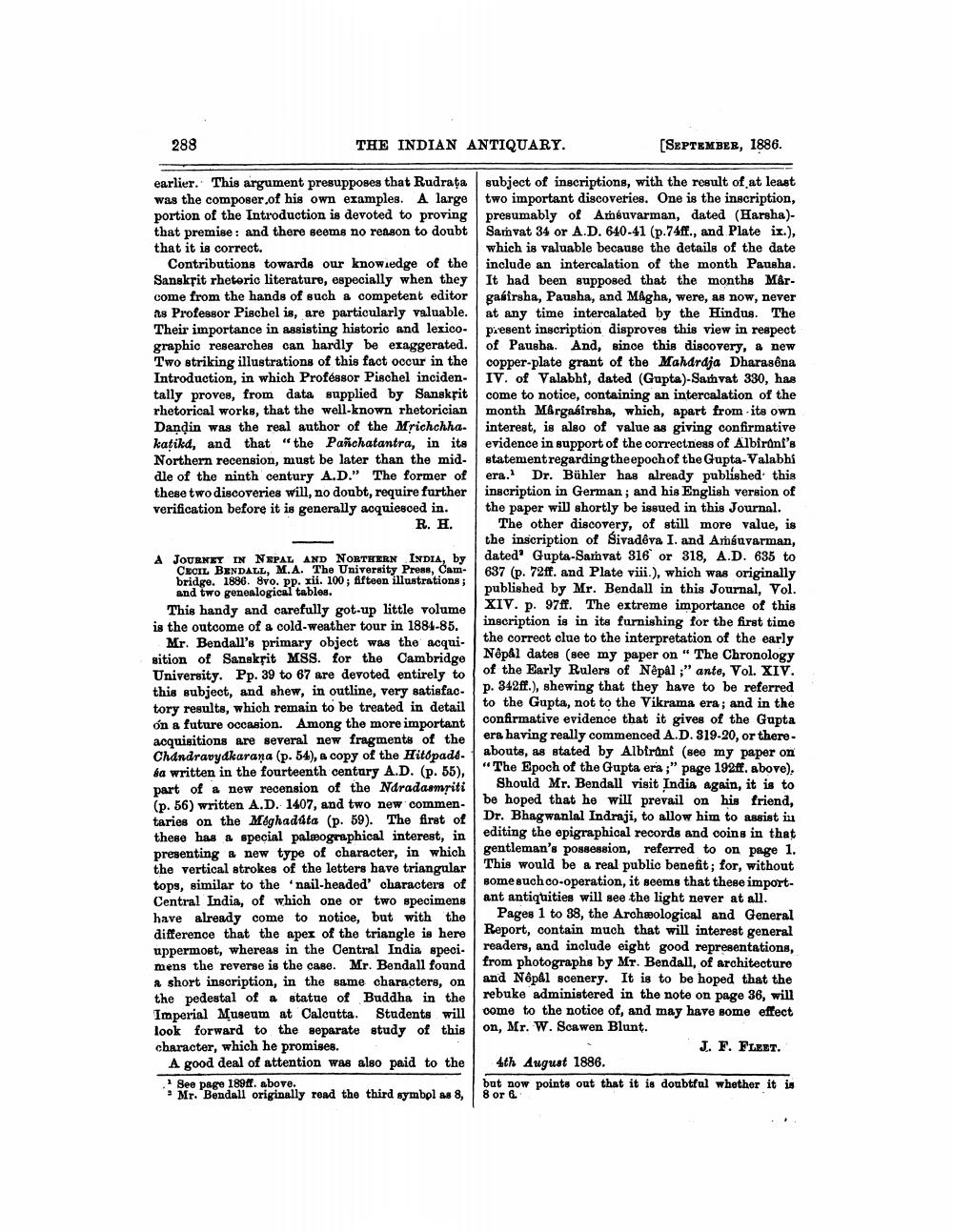________________
288
THE INDIAN ANTIQUARY.
[SEPTEMBER, 1886.
earlier. This argument presupposes that Rudrata subject of inscriptions, with the result of at least was the composer of his own examples. A large two important discoveries. One is the inscription, portion of the Introduction is devoted to proving presumably of Améuvarman, dated (Harsha)that premise: and there seems no reason to doubt Samvat 34 or A.D. 640-41 (p.74ff., and Plate in.), that it is correct.
which is valuable because the details of the date Contributions towards our knowledge of the include an intercalation of the month Pausha. Sanskfit rhetoric literature, especially when they It had been supposed that the months Mårcome from the hands of such a competent editor gabirsha, Pausha, and Magha, were, as now, never as Professor Pischel is, are particularly valuable. at any time intercalated by the Hindus. The Their importance in assisting historic and lexico- present inscription disproves this view in respect graphic researches can hardly be exaggerated. of Pausba. And, since this discovery, a new Two striking illustrations of this fact occur in the copper-plate grant of the Maharaja Dharasêna Introduction, in which Professor Pischel inciden- IV. of Valabhi, dated (Gupta)-Samvat 330, has tally proves, from data supplied by Sanskrit come to notice, containing an intercalation of the rhetorical works, that the well-known rhetorician month Mârgasirsha, which, apart from its own Dandin was the real author of the Mrichchha interest, is also of value as giving confirmative katikd, and that "the Panchatantra, in its evidence in support of the correctness of Albirani's Northern recension, must be later than the mid- statement regarding theepoch of the Gupta- Valabhi dle of the ninth century A.D." The former of era. Dr. Bühler has already published this these two discoveries will, no doubt, require further inscription in German; and his English version of verification before it is generally acquiesced in. the paper will shortly be issued in this Journal.
R. H. The other discovery, of still more value, is
the inscription of Sivadêva I. and Amsuvarman, A JOURNEY IN NEPAL AND NORTHERN INDIA, by dated' Gupta-Samvat 316 or 318, A.D. 635 to
CECIL BENDALL, M.A. The University Press, Cam- 637 (p. 72ff. and Plate viii.), which was originally bridge. 1886. 8vo. pp. xii. 100; fifteen illustrations ; and two genealogical tables.
published by Mr. Bendall in this Journal, Vol. This handy and carefully got-up little volume
XIV. p. 97ff. The extreme importance of this is the outcome of a cold-weather tour in 1884-85. inscription is in its furnishing for the first time Mr. Bendall's primary object was the acqui
the correct clue to the interpretation of the early sition of Sanskrit MSS. for the Cambridge Népal dates (see my paper on " The Chronology University. Pp. 39 to 67 are devoted entirely to
of the Early Rulers of Nepal," ante, Vol. XIV. this subject, and shew, in outline, very satisfac. p. 3121.), shewing that they have to be referred tory results, which remain to be treated in detail to the Gupta, not to the Vikrama era, and in the on a future occasion. Among the more important
confirmative evidence that it gives of the Gupta acquisitions are several new fragments of the
era having really commenced A.D. 319-20, or thereChandravydkarana (p. 54), a copy of the Hitdpadd.
aboute, as stated by Albirunf (see my paper on sa written in the fourteenth century A.D. (p. 55),
"The Epoch of the Gupta era ;" page 192ff. above). part of a new recension of the Ndradasmriti
Should Mr. Bendall visit India again, it is to (p. 56) written A.D. 1407, and two new commen- be hoped that he will prevail on his friend, taries on the Meghadata (p. 59). The first of
Dr. Bhagwanlal Indraji, to allow him to assist in these has a special palæographical interest, in editing the epigraphical records and coins in that presenting a new type of character, in which
pasterin which gentleman's possession, referred to on page 1. the vertical strokes of the letters have triangular This would be a real public benefit; for, without tops, similar to the nail-headed' characters of
some such co-operation, it seems that these importCentral India, of which one or two specimens
ant antiquities will see the light never at all. have already come to notice, but with the
Pages 1 to 38, the Archeological and General difference that the apex of the triangle is here
Report, contain much that will interest general uppermost, whereas in the Central India speci.
readers, and include eight good representations, mens the reverse is the case. Mr. Bendall found
from photographs by Mr. Bendall, of architecture short inscription, in the same characters, on
and Népal scenery. It is to be hoped that the the pedestal of a statue of Buddha in the
rebuke administered in the note on page 36, will Imperial Museum at Calcutta. Students will come to the notice of, and may have some effect look forward to the separate study of this on, Mr. W. Scawen Blunt. character, which he promises.
J. F. FLEET. A good deal of attention was also paid to the 4th August 1886. See page 189ff. above.
but now points out that it is doubtful whether it is • Mr.Bendall originally read the third symbol as 8, 8 or .




